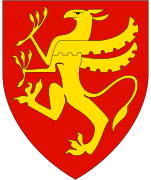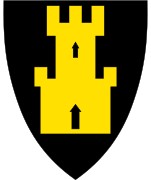Berg, Norway
Berg is a former municipality that was located in the old Troms county, Norway. The municipality existed from 1838 until its dissolution in 2020 when it was merged into the new Senja Municipality. The administrative centre of the municipality was the village of Skaland. Other villages included Finnsæter, Mefjordvær, and Senjahopen. The municipality is located on the western part of the large island of Senja.
Berg kommune Birgi suohkan | |
|---|---|
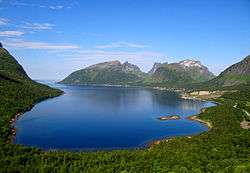 | |
 Coat of arms 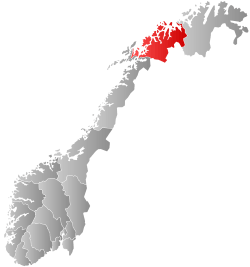 Troms within Norway | |
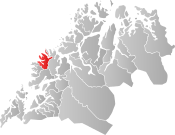 Berg within Troms | |
| Coordinates: 69°28′00″N 17°23′52″E | |
| Country | Norway |
| County | Troms |
| District | Midt-Troms |
| Established | 1 Jan 1838 |
| Disestablished | 1 Jan 2020 |
| Administrative centre | Skaland |
| Area | |
| • Total | 293.89 km2 (113.47 sq mi) |
| • Land | 276.34 km2 (106.70 sq mi) |
| • Water | 17.55 km2 (6.78 sq mi) 6% |
| Area rank | 281 in Norway |
| *Area at municipal dissolution. | |
| Population (2018) | |
| • Total | 902 |
| • Rank | 406 in Norway |
| • Density | 3.3/km2 (9/sq mi) |
| • Change (10 years) | -3.7% |
| Demonym(s) | Bergsværing[1] |
| Time zone | UTC+01:00 (CET) |
| • Summer (DST) | UTC+02:00 (CEST) |
| ISO 3166 code | NO-1929 |
| Official language form | Bokmål[2] |
| Created as | Formannskapsdistrikt in 1838 |
| Succeeded by | Senja in 2020 |
At the time of its dissolution as a municipality on 1 January 2020, the 294-square-kilometre (114 sq mi) municipality was the 281st largest by area out of the 422 municipalities in Norway. Berg was also the 406th most populous municipality in Norway with a population of 902. The municipality's population density was 3.3 inhabitants per square kilometre (8.5/sq mi) and its population has decreased by 3.7% over the previous decade.[3][4]
The municipality was the first place in the world to utilize a hydroelectrical power station in the mining community of Hamn. When the mining industry ceased, the "electrical adventure" did as well. The buildings are still located at Hamn, now functioning as a special hotel/lodge.
The first female pastor in the Lutheran Church of Norway, Ingrid Bjerkås, worked in this parish, starting in 1961.
General information

Berg was established as a municipality on 1 January 1838 (see formannskapsdistrikt). The southern part of Berg (population: 1,229) was separated from Berg to form the new Torsken Municipality on 1 January 1902. This left Berg with 1,002 residents. The municipal borders have not changed since.[5]
In March 2017, the Parliament of Norway voted to merge the municipalities of Berg, Torsken, Lenvik, and Tranøy. The new municipality will encompass the whole island of Senja plus part of the mainland. The new Senja Municipality will be established on 1 January 2020.[6][7]
Name
The municipality (originally the parish) is named after the old Berg farm (Old Norse: Bærg) in what is now the village of Skaland. The farm is where Berg Church is located. The name is identical with the word berg which means "mountain".[8]
Coat of arms
The coat of arms is from modern times; they were granted on 2 October 1987. The gray/white and black arms are canting since "berg" means "mountain" in Norwegian and the arms show the profile of the three mountains of Trælen, Oksen, and Kjølva. The colors represent "winter darkness", "black sea", and "toward brighter times."[9][10]
Churches
The Church of Norway has one parish (sokn) within the municipality of Berg. It is part of the Senja prosti (deanery) in the Diocese of Nord-Hålogaland.
| Parish (Sokn) | Church Name | Location of the Church | Year Built |
|---|---|---|---|
| Berg | Berg Church | Skaland | 1955 |
| Finnsæter Chapel | Finnsæter | 1982 | |
| Mefjordvær Chapel | Mefjordvær | 1916 |
Geography

The municipality faces the Atlantic Ocean on the west side of the large island of Senja. The largest urban area in Berg is the village of Senjahopen. The highest point on the island, the mountain Breidtinden, is located in the northeastern part of Berg. There are three large fjords that cut into the municipality: Bergsfjorden, Ersfjorden, and Mefjorden.
Climate
| Climate data for Skaland, Berg | |||||||||||||
|---|---|---|---|---|---|---|---|---|---|---|---|---|---|
| Month | Jan | Feb | Mar | Apr | May | Jun | Jul | Aug | Sep | Oct | Nov | Dec | Year |
| Daily mean °C (°F) | −2.5 (27.5) |
−2.5 (27.5) |
−1.4 (29.5) |
1.2 (34.2) |
5.3 (41.5) |
8.8 (47.8) |
11.3 (52.3) |
11.1 (52.0) |
7.8 (46.0) |
4.1 (39.4) |
0.6 (33.1) |
−1.6 (29.1) |
3.5 (38.3) |
| Average precipitation mm (inches) | 109 (4.3) |
94 (3.7) |
88 (3.5) |
77 (3.0) |
55 (2.2) |
67 (2.6) |
77 (3.0) |
91 (3.6) |
115 (4.5) |
152 (6.0) |
129 (5.1) |
131 (5.2) |
1,185 (46.7) |
| Source: Norwegian Meteorological Institute[11] | |||||||||||||
Government
All municipalities in Norway, including Berg, are responsible for primary education (through 10th grade), outpatient health services, senior citizen services, unemployment and other social services, zoning, economic development, and municipal roads. The municipality is governed by a municipal council of elected representatives, which in turn elect a mayor.[12] The municipality falls under the Senja District Court and the Hålogaland Court of Appeal.
Municipal council
The municipal council (Kommunestyre) of Berg was made up of 15 representatives that were elected to four year terms. The party breakdown of the final municipal council was as follows:
| Party Name (in Norwegian) | Number of representatives | |
|---|---|---|
| Labour Party (Arbeiderpartiet) | 6 | |
| Progress Party (Fremskrittspartiet) | 1 | |
| Berg Common List (Berg samlingsliste) | 6 | |
| Berg Common List (Berg Fellesliste) | 2 | |
| Total number of members: | 15 | |
| Party Name (in Norwegian) | Number of representatives | |
|---|---|---|
| Labour Party (Arbeiderpartiet) | 6 | |
| Progress Party (Fremskrittspartiet) | 1 | |
| Berg Common List (Berg samlingsliste) | 5 | |
| Berg Common List (Berg Fellesliste) | 3 | |
| Total number of members: | 15 | |
| Party Name (in Norwegian) | Number of representatives | |
|---|---|---|
| Labour Party (Arbeiderpartiet) | 6 | |
| Progress Party (Fremskrittspartiet) | 1 | |
| Conservative Party (Høyre) | 1 | |
| Centre Party and Cross-Party List (Senterpartiet og Tverrpolitisk liste) | 5 | |
| Berg common list (Berg fellesliste) | 2 | |
| Total number of members: | 15 | |
| Party Name (in Norwegian) | Number of representatives | |
|---|---|---|
| Labour Party (Arbeiderpartiet) | 7 | |
| Progress Party (Fremskrittspartiet) | 1 | |
| Northern Berg common list (Nordre-Berg Fellesliste) | 7 | |
| Cross-party list (Tverrpolitisk liste) | 2 | |
| Total number of members: | 17 | |
| Party Name (in Norwegian) | Number of representatives | |
|---|---|---|
| Labour Party (Arbeiderpartiet) | 8 | |
| Cross-party list (Tverrpolitisk liste) | 4 | |
| Mefjorden local list (Mefjorden bygdeliste) | 3 | |
| Senjahopen new local list (Senjahopen nye bygdeliste) | 2 | |
| Total number of members: | 17 | |
| Party Name (in Norwegian) | Number of representatives | |
|---|---|---|
| Labour Party (Arbeiderpartiet) | 7 | |
| Cross-party list (Tverrpolitisk liste) | 4 | |
| Senjahopen local list (Senjahopen Bygdeliste) | 5 | |
| People's list in Southern Berg (Folkelista/Folkevalgte i Sondre Berg) | 1 | |
| Total number of members: | 17 | |
| Party Name (in Norwegian) | Number of representatives | |
|---|---|---|
| Labour Party (Arbeiderpartiet) | 7 | |
| Christian Democratic Party (Kristelig Folkeparti) | 1 | |
| Socialist Left Party (Sosialistisk Venstreparti) | 2 | |
| Cross-party list (Tverrpolitisk liste) | 3 | |
| Senjahopen local list (Senjahopen Bygdeliste) | 4 | |
| Total number of members: | 17 | |
| Party Name (in Norwegian) | Number of representatives | |
|---|---|---|
| Labour Party (Arbeiderpartiet) | 11 | |
| Conservative Party (Høyre) | 1 | |
| Christian Democratic Party (Kristelig Folkeparti) | 1 | |
| District list for Northern Berg (Distriktsliste for Nordre Berg) | 1 | |
| Senjahopen local list (Senjahopen Bygdeliste) | 2 | |
| Berg independent socialists common list (Berg uavhengige sosialisters fellesliste) | 1 | |
| Total number of members: | 17 | |
| Party Name (in Norwegian) | Number of representatives | |
|---|---|---|
| Labour Party (Arbeiderpartiet) | 11 | |
| Conservative Party (Høyre) | 2 | |
| Christian Democratic Party (Kristelig Folkeparti) | 1 | |
| District list for Northern Berg (Distriktsliste for Nordre Berg) | 2 | |
| Berg independent socialists common list (Berg uavhengige sosialisters fellesliste) | 1 | |
| Total number of members: | 17 | |
| Party Name (in Norwegian) | Number of representatives | |
|---|---|---|
| Labour Party (Arbeiderpartiet) | 7 | |
| Conservative Party (Høyre) | 2 | |
| Christian Democratic Party (Kristelig Folkeparti) | 2 | |
| District list for Mefjordvær (Distriktsliste for Mefjordvær) | 2 | |
| Senjahopen local list (Senjahopen bygdelist) | 3 | |
| Independent socialist common list (Uavhengig sosialistisk fellesliste) | 1 | |
| Total number of members: | 17 | |
| Party Name (in Norwegian) | Number of representatives | |
|---|---|---|
| Labour Party (Arbeiderpartiet) | 8 | |
| District list for Berg (Distriktsliste for Berg) | 3 | |
| District list for Mefjordvær (Distriktsliste for Mefjordvær) | 2 | |
| Local list for Senjehopen (Bygdeliste for Senjehopen) | 4 | |
| Total number of members: | 17 | |
| Party Name (in Norwegian) | Number of representatives | |
|---|---|---|
| Labour Party (Arbeiderpartiet) | 8 | |
| Local List(s) (Lokale lister) | 9 | |
| Total number of members: | 17 | |
| Party Name (in Norwegian) | Number of representatives | |
|---|---|---|
| Labour Party (Arbeiderpartiet) | 12 | |
| Local List(s) (Lokale lister) | 5 | |
| Total number of members: | 17 | |
| Party Name (in Norwegian) | Number of representatives | |
|---|---|---|
| Labour Party (Arbeiderpartiet) | 10 | |
| Local List(s) (Lokale lister) | 7 | |
| Total number of members: | 17 | |
| Party Name (in Norwegian) | Number of representatives | |
|---|---|---|
| Labour Party (Arbeiderpartiet) | 7 | |
| Local List(s) (Lokale lister) | 6 | |
| Total number of members: | 13 | |
| Party Name (in Norwegian) | Number of representatives | |
|---|---|---|
| Labour Party (Arbeiderpartiet) | 9 | |
| Local List(s) (Lokale lister) | 4 | |
| Total number of members: | 13 | |
| Party Name (in Norwegian) | Number of representatives | |
|---|---|---|
| Labour Party (Arbeiderpartiet) | 8 | |
| Liberal Party (Venstre) | 3 | |
| Local List(s) (Lokale lister) | 1 | |
| Total number of members: | 12 | |
| Party Name (in Norwegian) | Number of representatives | |
|---|---|---|
| Local List(s) (Lokale lister) | 12 | |
| Total number of members: | 12 | |
| Party Name (in Norwegian) | Number of representatives | |
|---|---|---|
| Local List(s) (Lokale lister) | 12 | |
| Total number of members: | 12 | |
| Party Name (in Norwegian) | Number of representatives | |
|---|---|---|
| Labour Party (Arbeiderpartiet) | 7 | |
| Local List(s) (Lokale lister) | 5 | |
| Total number of members: | 12 | |
References
- "Navn på steder og personer: Innbyggjarnamn" (in Norwegian). Språkrådet.
- "Forskrift om målvedtak i kommunar og fylkeskommunar" (in Norwegian). Lovdata.no.
- Statistisk sentralbyrå (2018). "Table: 06913: Population 1 January and population changes during the calendar year (M)" (in Norwegian). Retrieved 2018-12-10.
- Statistisk sentralbyrå. "09280: Area of land and fresh water (km²) (M)" (in Norwegian). Retrieved 2018-12-10.
- Jukvam, Dag (1999). "Historisk oversikt over endringer i kommune- og fylkesinndelingen" (PDF) (in Norwegian). Statistisk sentralbyrå.
- "Senja kommune 2020" (in Norwegian). Retrieved 2017-09-09.
- Vermes, Thomas (2017-03-29). "Stortingsflertallet gjør fire Senja-kommuner til én". ABC Nyheter (in Norwegian). Retrieved 2017-09-09.
- Rygh, Oluf (1911). Norske gaardnavne: Troms amt (in Norwegian) (17 ed.). Kristiania, Norge: W. C. Fabritius & sønners bogtrikkeri. pp. 72–73.
- "Beskrivelse av kommunevåpenet" (in Norwegian). Retrieved 2008-12-01.
- "Civic heraldry of Norway - Norske Kommunevåpen". Heraldry of the World. Retrieved 2017-09-07.
- "eKlima Web Portal". Norwegian Meteorological Institute. Archived from the original on 2004-06-14.
- Hansen, Tore, ed. (2016-05-12). "kommunestyre". Store norske leksikon (in Norwegian). Kunnskapsforlaget. Retrieved 2018-08-23.
- "Table: 04813: Members of the local councils, by party/electoral list at the Municipal Council election (M)" (in Norwegian). Statistics Norway.
- "Tall for Norge: Kommunestyrevalg 2011 - Troms Romsa". Valg Direktoratet. Retrieved 2019-10-24.
- "Kommunestyrevalget 1995" (PDF) (in Norwegian). Oslo-Kongsvinger: Statistisk sentralbyrå. 1996. Retrieved 2020-03-18.
- "Kommunestyrevalget 1991" (PDF) (in Norwegian). Oslo-Kongsvinger: Statistisk sentralbyrå. 1993. Retrieved 2020-03-18.
- "Kommunestyrevalget 1987" (PDF) (in Norwegian). Oslo-Kongsvinger: Statistisk sentralbyrå. 1988. Retrieved 2020-03-18.
- "Kommunestyrevalget 1983" (PDF) (in Norwegian). Oslo-Kongsvinger: Statistisk sentralbyrå. 1984. Retrieved 2020-03-18.
- "Kommunestyrevalget 1979" (PDF) (in Norwegian). Oslo: Statistisk sentralbyrå. 1979. Retrieved 2020-03-18.
- "Kommunevalgene 1975" (PDF) (in Norwegian). Oslo: Statistisk sentralbyrå. 1977. Retrieved 2020-03-18.
- "Kommunevalgene 1972" (PDF) (in Norwegian). Oslo: Statistisk sentralbyrå. 1973. Retrieved 2020-03-18.
- "Kommunevalgene 1967" (PDF) (in Norwegian). Oslo: Statistisk sentralbyrå. 1967. Retrieved 2020-03-18.
- "Kommunevalgene 1963" (PDF) (in Norwegian). Oslo: Statistisk sentralbyrå. 1964. Retrieved 2020-03-18.
- "Kommunevalgene og Ordførervalgene 1959" (PDF) (in Norwegian). Oslo: Statistisk sentralbyrå. 1960. Retrieved 2020-03-18.
- "Kommunevalgene og Ordførervalgene 1955" (PDF) (in Norwegian). Oslo: Statistisk sentralbyrå. 1957. Retrieved 2020-03-18.
- "Kommunevalgene og Ordførervalgene 1951" (PDF) (in Norwegian). Oslo: Statistisk sentralbyrå. 1952. Retrieved 2020-03-18.
- "Kommunevalgene og Ordførervalgene 1947" (PDF) (in Norwegian). Oslo: Statistisk sentralbyrå. 1948. Retrieved 2020-03-18.
- "Kommunevalgene og Ordførervalgene 1945" (PDF) (in Norwegian). Oslo: Statistisk sentralbyrå. 1947. Retrieved 2020-03-18.
- "Kommunevalgene og Ordførervalgene 1937" (PDF) (in Norwegian). Oslo: Statistisk sentralbyrå. 1938. Retrieved 2020-03-18.
External links
| Wikimedia Commons has media related to Berg (Senja). |
| Look up Berg in Wiktionary, the free dictionary. |


